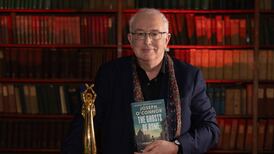Born: January 21st, 1950
Died: June 17th, 2025
The proof that early influences can be long-lasting was exemplified in the life of the Irish mime artist, actor and theatre director Vincent O’Neill, who died in his adopted home of Buffalo, New York state, at the age of 75 on June 17th.
Based there since 1990, O’Neill was renowned and much loved by his host community, becoming in time chair of the Department of Theatre and Dance at the State University of New York at Buffalo (2001) and being named Outstanding Citizen of the Year by The Buffalo News (2015).
RM Block
Born in Dublin in January, 1950, O’Neill was one of five children of a civil servant, Leo O’Neill, a principal officer at the Department of Finance originally from west Cork , and Helen, née Casey, from a family of tailors in Capel Street, in Dublin’s inner city.
Raised in Dundela Park, Sandycove, O’Neill and his brother Chris, later himself an acclaimed actor, had their first lessons in drama as small children at a theatre school run by a well-known Dublin theatrical couple of that period, George and Audrey Meredith, in Silchester Park, Glenageary,
After schooling at CBC Monkstown, O’Neill gained an honours degree in Spanish and French at UCD, and a higher diploma in education at Trinity College Dublin before teaching for several years at Manor House School in Raheny, where he bought a house.
His primary passion, though, was for theatre, and a meeting in Paris with Marcel Marceau, at a time when the great French mime artist was setting up his academy there, prompted in him a radical change of career course.
Already acting part-time at the Abbey Theatre since 1973, he made the huge decision to sell his house to fund a new life, joining Marceau’s first intake of students in 1978.
On graduating three years later, he returned to Dublin where his then rare talents and training brought him back to the Abbey. There he was to make a singularly significant contribution in ground-breaking productions of what was then, for Irish audiences, a totally new type of physical theatre.
This was perhaps best exemplified by director Patrick Mason’s and writer Tom McIntyre’s experimental works, especially the latter’s adaptation of Patrick Kavanagh’s The Great Hunger in 1986, in which O’Neill created the role of the Priest, and in which the late Tom Hickey played the lead.
Actor Jack Walsh, himself a graduate of the Marceau school, the rigours of which he memorably described in an article in The Irish Times in 2007, said last week that O’Neill had made a “hugely important and amazing” impact on the Abbey. “I remember thinking to myself, ‘that’s how you combine word and the body’.” Inspired, Walsh followed O’Neill’s example and went to Paris.
Walsh said O’Neill and another early Irish graduate of Marceau’s school, the late Conal Kearney, “had a huge influence on The Great Hunger, “combining Irish poetry with European theatre”.
Leaving the Abbey in 1988, O’Neill joined his brother Chris at the Oscar Theatre School of Acting in Sandymount, Dublin, where he applied to the Arts Council for funding to establish the first Irish school of mime. The application was turned down, something Walsh believes to have been a “major factor” in O’Neill’s decision to emigrate.
In 1990, O’Neill joined his brother, who had already relocated to Buffalo, where, along with O’Neill’s then wife, actor Josephine Hogan, they established the Irish Classical Theatre Company (ICTC) to produce great Irish plays for an American audience. O’Neill taught at the State University of New York at Buffalo, as director of theatre performance, from 1990.
In a comment to The Buffalo News, local theatre critic Anthony Chase said: “Vincent O’Neill transformed the Buffalo theatre landscape in terms of standards for locally produced theatre, and that locally produced theatre could be of national importance. As an artist, he was a man of uncommon talent, depth and versatility.”
The woman who succeeded him as artistic director of the ICTC in 2020, Kate LoConti Alcocer, told the newspaper that “as a mentor, he reinforced how incredibly important it is to pay attention to details, whether as an actor, or as an artistic director. Vincent’s ability to take care of even the smallest of details is something I continuously incorporate in my work.”
Artist and designer David Butler told The Buffalo News regarding the impact of the ICTC that “when [O’Neill] and his brother arrived in Buffalo, they raised the bar for local theatre so high it affected everyone … you always strived to do your best work at Irish Classical Theatre. You always stretched to reach that level.”
Actor Arin Lee Dandes, recalling O’Neill’s mime classes after his death, said in an online tribute: “He taught us how to say so much without saying a single word ... the way he could take you to another world and embody character with a shift of posture was something I had never seen.”
University of Buffalo president Satish K Tripathi wrote of O’Neill’s tenure at UB: “Vincent was an uncommonly gifted artist and a visionary champion of the arts whose devotion to theatre had a profound impact on our university community and the cultural fabric of our city.”
In 2022, O’Neill was honoured as the Buffalo Theatre District’s Plaza of Stars inductee, where his “star” was officially unveiled in a ceremony in the Plaza of Stars in the city’s downtown district.
Vincent O’Neill is survived by his wife Teja Rao, his former wife Josephine Hogan, his two children with Ms Hogan Jamie and Laura, and his sister Margaret Boucher. He was predeceased by his brothers Chris and Paddy and his sister Helen.


















